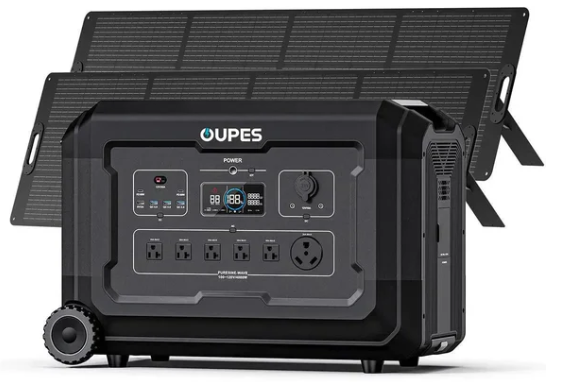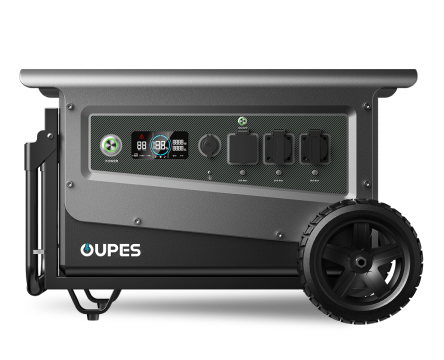
Overview
Many solar users—especially off-grid homeowners, RV travelers, and portable power station users—wonder whether a bright full moon can produce any usable solar electricity. After all, the moon reflects sunlight, and on a clear night a full moon can illuminate the ground surprisingly well.
This article explains, using data from NASA and NREL (National Renewable Energy Laboratory), how much solar energy actually reaches your panels during a full moon, how this affects portable solar generators such as those from OUPES, and whether moonlight can meaningfully charge batteries.
How Solar Panels Generate Electricity
Photovoltaic Basics
Solar panels work by converting photons—particles of light—into electrical current. The more photons that strike the panel, the more electricity is produced. Electricity output depends on:
- Light intensity (irradiance measured in W/m²)
- Wavelength distribution of light
- Panel efficiency
- Temperature
Why Light Intensity Matters Most
Under full sunlight, irradiance at Earth’s surface is about 1,000 W/m². Solar panels are designed to operate optimally under these conditions. At lower light levels—such as at dawn, dusk, or during heavy clouds—power output decreases proportionally.
Moonlight is dramatically dimmer, which is the core reason solar output drops to near zero at night.
Does Moonlight Produce Solar Power?
Moonlight Is Reflected Sunlight
Moonlight is not generated by the moon itself; it is reflected sunlight. However, the moon only reflects about 12% of the light that hits it (NASA albedo data). Additionally:
- The moon is far smaller than the sun
- The reflected light spreads in all directions instead of being concentrated
- The distance and angle from Earth further reduce photon density
The result: full moon irradiance at Earth's surface is approximately 0.001 lux to 0.3 lux, compared to 100,000 lux for direct sunlight.
Can Solar Panels Detect Moonlight?
Technically, solar panels can detect moonlight because it contains photons. However, the intensity is so low that modern panels cannot produce measurable voltage or current. In other words:
Moonlight does not generate usable solar power.
Real Power Output Under Full Moonlight
Engineering Estimate of Expected Output
Based on irradiance data, the brightness ratio of sunlight to full moonlight is approximately:
Sunlight is about 400,000–1,000,000 times brighter than full moonlight.
Using this ratio, we can calculate expected output:
If a 200W panel produces 200W in direct sunlight:
Under full moonlight it would generate approximately:
0.0002W to 0.0005W (0.2–0.5 milliwatts)
Why Systems Show Zero Output
Solar charge controllers—including MPPT systems inside portable power stations such as those made by OUPES—have minimum activation voltages. Moonlight cannot generate enough voltage to meet these thresholds, so the display reads **0W** even though minuscule photon activity still occurs.
Sunlight vs. Moonlight Comparison Table
| Condition | Irradiance (W/m²) | Panel Output (200W panel) |
|---|---|---|
| Full Sun (Clear Day) | 800–1,000 | 180–200W |
| Cloudy Day | 100–400 | 20–80W |
| Twilight | 1–10 | 0.2–2W |
| Full Moon | 0.0001–0.001 | 0.0002–0.0005W (negligible) |
Even the darkest cloudy day provides thousands of times more usable energy than a full moon.
How Full Moonlight Affects Solar Generators & Portable Power Stations
1. No Meaningful Battery Charging
Portable solar generators (such as OUPES units) require a minimum voltage—typically around 12–18V input—to begin charging. Moonlight cannot generate this voltage, so portable power stations do not charge at night.
2. MPPT Charge Controllers Do Not Activate
MPPT controllers track voltage/current curves to maximize power harvest. Under moonlight, voltage is near zero, so the controller shuts down automatically to protect the system.
3. No Effect on Battery Drain
Some users worry whether moonlight might somehow cause reverse current flow. This does not occur because:
- Controllers prevent reverse current
- Moonlight cannot create negative voltage conditions
4. Why Panels Still Appear “Active” on Some Apps
Some home solar inverters show tiny “sensor readings” at night (0.1W, 0.2W). These are measurement artifacts—not real power generation.
Practical Considerations for Off-Grid Users
1. Plan Energy Storage for Nighttime
Because moonlight produces no usable power, nighttime energy must come from:
- Battery banks
- Portable power stations
- Backup generators (if applicable)
2. Oversize Panels for Short Winter Days
In northern latitudes, where winter days are short, solar output may drop to as low as 10–20% of summer levels (NREL irradiance data). Oversizing panels ensures enough charge accumulation before nightfall.
3. Use High-Efficiency LFP Power Stations
Portable solar generators using LiFePO4 batteries—like those from OUPES—offer long cycle life and high charging efficiency, making them ideal for capturing limited winter sunlight.
4. Consider Energy-Efficient Appliances
For off-grid nighttime operation, choose:
- 12V compressor fridges
- LED lighting
- Low-wattage heating blankets instead of space heaters
5. For RV Users: Expect No Night Charging
RV roof panels produce zero usable power at night. Full moonlight cannot meaningfully extend battery runtime.
FAQ
1. Can solar panels ever charge at night?
No. Traditional photovoltaic panels require direct or scattered sunlight. Moonlight is too weak to activate charge controllers or produce usable current.
2. Do solar panels work better during a full moon than new moon?
Technically yes—moonlight is brighter during a full moon—but the difference is still far below charging thresholds.
3. Will future technology allow nighttime solar charging?
Experimental thermoradiative solar cells are being researched but are not commercially available. Current solar panels cannot generate nighttime power.
4. Can portable power stations charge from moonlight?
No. Portable power stations require significantly higher voltage and current levels than moonlight can produce.
5. Does a bright moon damage solar panels?
No. Moonlight has no negative effect on PV modules.
6. How do off-grid homes get power at night?
Through stored energy in batteries or portable solar generators. This is why large LiFePO4 battery banks are the foundation of all off-grid systems.




























